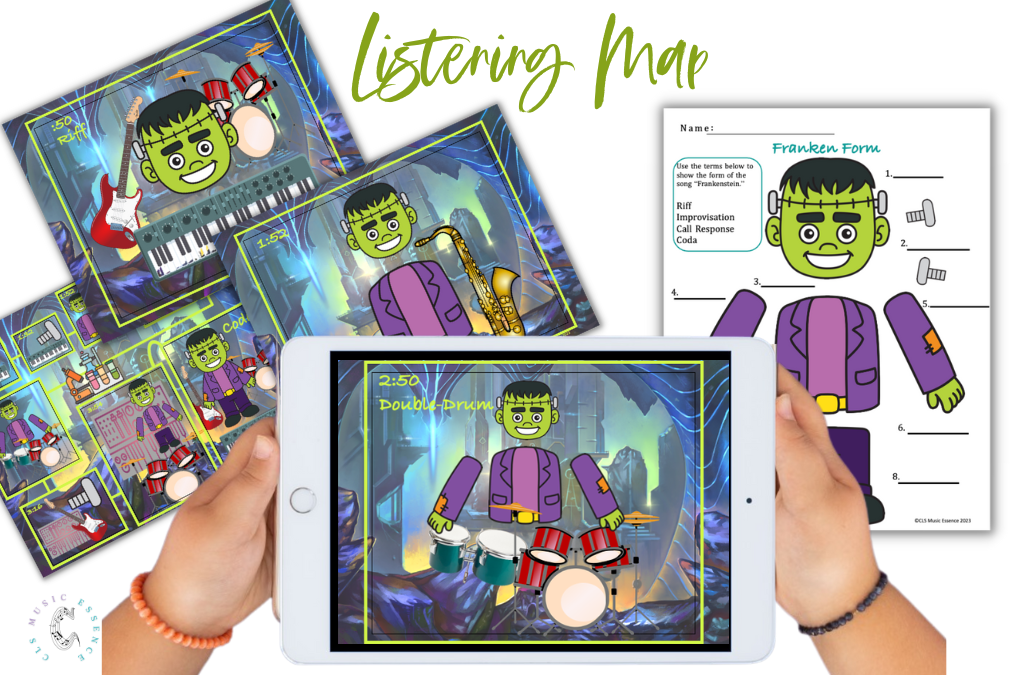5 thrilling Ways Edgar Winter Hit Monster Makes an Impact in the Music Classroom
Edgar Winter hit the charts with his 70s rock instrumental “Frankenstein.” This song is a rare rock song and one of the first to feature the synthesizer. Edgar Winter unleashed all his musical talents and created unheard-of sounds by twisting and turning nobs and the pitch bend. This mind-blowing rock song is the perfect song example to hook your students into music.
See similar ideas for Camile Saint Saëns tone poem “Danse Macabre.”
Vibe On A Rock Genre Edgar Winter Hit
Ever since the youth brought rock and roll front and center in the 1950s. Students continue to be drawn into the loud, distorted, pounding sounds on the drumset, bass, and electric guitar. How better to introduce a virtuoso instrumental piece than through a genre students will vibe with!
A great rock song often features an electrifying guitar solo, but it’s rare to find a rock song that is entirely instrumental until the Edgar Winter hit “Frankenstein.” Edgar was a true virtuoso on many instruments. Without the distraction of video games, or social media that didn’t exist in the 60s and 70s, Edgar spent hours just playing musical instruments.
Edgar was fortunate to grow up in a musical family and started singing and playing music by the age of 4. He relied heavily on his ability to play by ear. His piano teacher tapped into his strengths by playing classical music for him that Edgar would playback after just listening. Edgar played classical, jazz and combined it all into a progressive rock genre.
All those years of playing, and jamming with the band led to an Edgar Winter hit! “Frankenstein” reached #1 on the US singles charts in 1973. The album “They Only Come Out At Night” which featured the song peaked at three and remained on the Billboard Top 200 for eighty weeks and was certified gold in April of 1973 by selling over 500,000 units.
Compose A Class Monster
To piece together the form of this Edgar Winter hit “Frankenstein” the band quickly identified the opening riff as the head of the song and also used it in the coda at the end. For the middle section or body, arms, legs, and bolts, they sifted through cuts of music from several 20 to 30-minute jam sessions. What they ended up with is an instrumental improvisation and call-and-response patterns.
Along with movement to music, I really like to teach form with listening maps. This Edgar Winter hit is so fun when the instruments are paired with some Frankenstein clip art. The visual of a lair and a mad scientist concocting a potion brings it together. Making music organized and visually interesting keeps students engaged and deepens their understanding.


Use this song as a springboard to create your own monster. First ensure that students have an understanding of the music vocabulary terms: riff, improvisation, call and response, and coda. Next provide opportunities for students to compose their own riff, improvise on any instrument, and add a call and response by dueling on drums. Put it all together into a class hit.
Compare and Contrast Music Technology
Just as body parts were assembled to create a science fiction 8-foot monster in Mary Shelley’s 1818 novel, the Edgar Winter hit song “Frankenstein” was created by cutting down more than 60 minutes of recorded tape to become a 4-minute song.
In the 1970s songs were recorded on a thin mylar tape. To edit music, the tape needed to be physically sliced with a very sharp razor blade and joined together with splicing tape. This is how the Edgar Winter hit “Frankenstein” got its name. Song parts were draped over furniture around the control room. As the band was trying to figure out which splices to put it back together. The drummer, Chuck Ruff, spoke it into existence saying ‘Wow, man, it’s like Frankenstein.’
Create an entire lesson to compare and contrast music analog editing of the past to how easy it is to edit today with digital programs such as Garage Band or Band Lab.


Unleash the Power of the Synthesizer
What really brought the Edgar Winter Hit together was the discovery of the Synthesizer. Although the synthesizer was invented decades early, the synth of the 70s was smaller and more portable. Edgar was enamored with the sounds that a synthesizer could make. Edgar used the synth like a human voice that could produce infinity sounds with a pitch bend, vibrato, and growl. For Edgar, it was a limitless machine producing sounds as creative as one’s mind could imagine.
Edgar invented a body strap that went around his neck to hold the keyboard part of the synthesizer. He wanted the same freedom that guitar players had to move around on stage. It also enabled an ease of switching between and back and forth on all the instruments he improvised including the saxophone and timbales.
Reach Students Through Storytelling
Edgar Winter was born with albinism. A condition that was characterized by pale hair, skin, and eyes. Along with his unusual outward appearance, another common trait of being an albino is having poor eyesight. This meant Edgar could not participate in sports like so many others.
Edgar’s older brother Johnny (a famous blues and rock guitarist) shared the same traits but loved the limelight and desired to be center stage. Instead, Edgar felt like the “weird one.” While both brothers loved music, for Edgar music was a place to escape. He played instruments for hours and became a virtuoso on many including piano, saxophone, and drums. Despite his poor eyesight he learned to read music so he could also compose for a variety of instruments.
Music has the power to reach students! Sharing the stories of adversity helps students to feel understood. Often when meaningful stories are shared students take an interest. It opens up the door for them to relate, and lets them know they are not alone in what they may be facing. Edgar Winter used music as a hiding place that he could escape to.
Edgar Winter Hit “Frankenstein” Music Escape Room
Escape rooms feel like a reward to students. Tasks to complete the escape room help students to engage with new material and reinforce learning. In addition, the experience of escaping the music room makes the music lesson plan memorable. See the Edgar Winter hit made into a music escape room below!








Please send me an email with your details of your books.
An quote/ price for the Around thd World Music resource and the Ukelele.
I would like to request my school to purchase it for me…